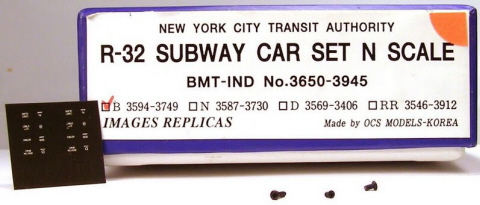Budd R-32

Pullman-Standard R-46

ACF R-26

Budd R-32

Pullman-Standard R-46

ACF R-26

Introduced: circa late 1990's
All of these Images Replicas brass NYC subway cars were sold in two-car powered / dummy sets. The only releases that I know of are the above-pictured R-32, R-46 and R-26 sets. I'm not exactly sure when they were manufactured, but I'm assuming late 90s (give or take). I'm told that the R-26 sets were special insofar as they were never sold directly to the public. Rather, they were a private project commissioned by the MTA and distributed solely to MTA workers (50 sets in total).
The R-32 and R-46 cars have different mechanisms. I've never owned an R-46 (or R-26) set, but the R-32 mechanism is very much reminescent of other Korean-made brass locos of the era (from the likes of Ajin, for example) -

The chassis is all metal and fairly light. The motor is a skew-wound 5-poler with dual flywheels. Metal driveshafts with dogbone / notched-cup U-joints connect the flywheels to the wormshafts. All four axles are geared, with the gearing being a mixture of black plastic and brass. All wheels collect current by way of flimsy wheel-top wipers. Current is tranferred from the wipers to the motor via wires (two wires per truck). The trucks are held to the chassis courtesy of sprung screws on the outboard side of each truck (a very odd system, and one that I've certainly never seen before). There is no lighting or window glazing. Each set supposedly includes a packet of spare parts (extra screws, etc), but the used set that I picked up on eBay was not so equipped. Stickers for the various lines that said cars would have operated on are also included.
These are great looking models, but mechanically they are just so-so (at best).
- The driveshafts are a bit short, which allows them to rattle around in their notched cups. The end result there is a fair amount of noise at the low end of the throttle and a whole lot of noise at the high end.
- The driveshafts will actually pop loose from their cups when running at full throttle (although of course one would never actually operate them at that speed).
- Over time, the flywheels have a tendency to work themselves loose and start sliding around on their motorshafts, thus exacerbating the driveshaft problem.
- The motor sits higher than the wormshafts in the trucks. Consequently, the motor tends to lift the truck on the end facing the motor, which could conceivably cause the inner wheels to lift high enough to derail.
- The metal chassis is extremely flimsy and prone to bending. Also, with only two small screws holding the shell to the chassis (one on each end), the shell has a tendency to sit crooked on the chassis if not constantly adjusted.
- Owing to the extremely close-coupling of the two cars, one or the other is guaranteed to derail on 11"-radius curves or sharper. I'd say the realistic minimum is right around 15" (which seems a bit unforgiving for subway cars).
- Pickup and throttle response seem decent enough, but wired wheeltop wipers are always dirt magnets and a huge pain to keep clean.

Grade: D